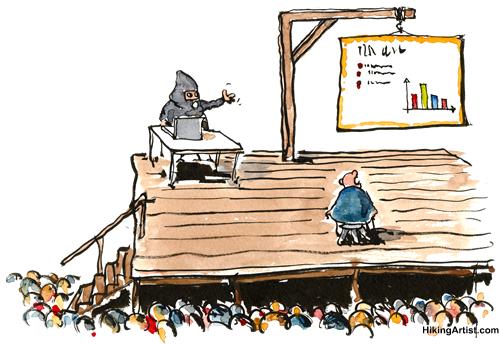
Friday was tough. Three reasons:
- Standard end of the week fatigue
- Massive and ongoing behavioural problems with a difficult Year 8 class
- Decidedly mixed feedback from the previous day’s observation
Number 3 was the hardest to take because (as is so often the case) it was fair and accurate and well-meant. A key issue was the pace of the lesson (also a factor in my ongoing battles with Year 8); my mentor felt it dragged, going flat when pupils should have been more engaged in what they were doing. She also felt this lack of urgency was tied to a perception that during whole class feedback I’d fill in any gaps in their understanding. If Sir was going to give the answers anyway, why spend effort on them first time round?
I’ve been reflecting on this a lot over the weekend; having done that it feels like my issues with pace may be connected to Powerpoint. I use it a lot less than I did when I was training last year (and oh how I cringe when I occasionally revisit those slides: so-many-WORDS! How did I ever think that was going to work?), but it’s now starting to feel like it is holding me back. After previously spending 15 years working in local government, I know what Death by Powerpoint looks like.
When I tweeted about this earlier, I had some interesting and supportive feedback. Some of it pointed me in the direction of this excellent post by Andy Tharby, on re-evaluating priorities for the classroom. When I read it, I was particularly struck by the following paragraph:
‘Typing on a slideshow what I could write on the board. So often my planning consists of writing things on a slide before a lesson that I could just as easily write on the board during the lesson! In fact, students seem to find this easier to follow – perhaps because their working memories are less likely to be bombarded with too much information. Of course, there are many benefits to projecting images, models and task lists but much of what I pre-prepare could simply be written there-and-then.‘
To quote ‘Despicable Me’: ‘Lightbulb!’
So from tomorrow, I’m going to try a week without it. No Powerpoint at all. I’ll still have the projector, so can bring up texts and use images and video clips when relevant. But anything that used to be on the slides? Written up on the board. This should make me more dynamic, and this dynamism will (I hope) find its way into my classes. It certainly feels worth a try. In withholding this information, I’m also going to be pushing my classes more for the answers, rather than allowing myself to fill in those gaps. If there’s less of my knowledge on the board for pupils to rely on, they’ll have to do more of their own thinking. Right?
We’ll see what actual difference it makes, but I am at least excited about trialling this new approach. And if next Friday ends more positively than the last one did, I’ll be content.

Let us know how the experiment goes! I think, even if I were to take all the notes off the slides, I would want to keep Powerpoint for images and questions; they are easily accessible, and take demand off my memory to remember what is next in the lesson.
So far so good Katie! I’m liking that it is adding pace to my lessons. Rather than looking at slides on screen, I’m facing my class more. Emphasis is on them to come up with more ideas, which is working well so far. I will still use it for images, and agree that it’s vital to know where the lesson is going.